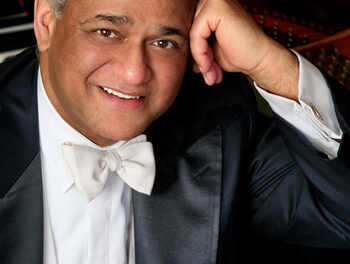A concert is a pure form of “performance art.” Even if it is recorded, the event, unique in time – and whether inspired, routine or insipid – can never be experienced in exactly the same way again. Unlike a studio recording, which can be edited or assembled from smaller takes to be note-perfect, a live performance often involves taking risks in an attempt to recreate a view of the composer’s intentions. Once in a while, a performance becomes greater than the sum of its parts, sweeping up performers and listeners in an intense, shared experience. To ride the crest of such a wave is the “high” for which musicians and music lovers long.
The concluding performance of the July 22 all-student Festival Orchestra concert in Dana Auditorium was just such an event. That Scott Sandmeier had prepared his student musicians well was evident in the three opening showpieces, discussed below. The main event was Rachmaninov’s well-known Piano Concerto No. 2, in c minor, for which faculty pianist Gideon Rubin took his place at the Steinway keyboard and began the soft solo opening with perfectly judged dynamics and phrasing. His deep, dark tone evoked the tolling of distant Russian bells better than any other live performance I have heard. The student string choirs beautifully matched this full, rich sound; the violas and cellos were especially fine during their prominent parts in the first movement. As the performance progressed, there was a palpable sense of everyone being galvanized by how “right” Gideon’s view of this warhorse sounded. Since the reading was without any stylistic distortions, it seemed that I was hearing the work for the first time. I will confess that I have always preferred the Third Piano Concerto and Rubin’s performance of the Second is the only one that ever totally grabbed me from the first note to the last. Significant solos within the orchestra were played by bassoonist Vanessa VanSickle, clarinetist Eve Galvani, and hornist Mitchel Dvoracek.
Two bleeding chunks of Wagner and a Liszt tone poem gave the young musicians a chance to strut their stuff, and they commanded full attention. Sandmeier led solid, straightforward, standard interpretations of all three works. Section ensemble was tight, and the rhythms were clearly defined. He cultivated a refined dynamic allowing for subtle nuance. The crucial repeated off-stage horn solo in “Siegfried’s Rhine Journey,” from Götterdämmerung, was played by Nick Calouri with gorgeous ringing tone and bright color. The important bass clarinet solo was played by Stephen Pfleiderer, while the pulse of the piece was underpinned by timpanist Adam Rosen. The “Ride of the Valkyries” from Die Walküre was appropriately stormy, with impressive playing from the horns and trombones. Sandmeier judged dynamics and phrasing ideally as he ratcheted up the waves of tension in Liszt’s Les Préludes. Key section solos were characterized strongly by clarinetist Orlando Scalia, oboist Noelle Drewes, and harpist Amanda Evans.











